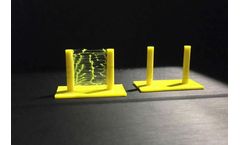Bio 3d Printing Articles & Analysis: Older
18 articles found
One of the most important components for successful 3D printing is the ‘bioink’, the cell-laden biomaterial used to create the printed structure. ...
JUST (aka Eat Just & now GOOD Meat) (US, 2011, beef) — best known for its work in plant-based eggs, but also working on cell-based Wagyu beef as a side hustle and now world-famous for being the first cultured-meat to get government regulatory approval (for its cultured chicken bites) and claims the title of first commercial sale of cultured meat Lab Farm Foods (US, 2019, ...
Researchers from Nanyang Technological University and its Center for 3D printing (SC3DP) have developed a 3D printed a highly repeatable and scalable three-dimensional in-vitro alveolar lung model using our REGENHU bioprinter, that could be exploited for pathogen translocation studies and respiratory-related toxicological testing ...
ByRegenhu
Researchers from Albert-Ludwigs-Universität Freiburg im Breisgau, Université Claude Bernard Lyon 1, Universidad Central “Marta Abreu” de Las Villas and Johannes Gutenberg-Universität Mainz developed a 3d printable, bioinspired hydrogel composed of two different biopolymers, chitosan and cellulose nanofibers, through an environmentally friendly process by avoiding both ...
ByRegenhu
Researchers from IRCCS Istituto Ortopedico Rizzoli and Indian Institute of Technology, Delhi (IIT) used their REGENHU bioprinters to fabricate an in vitro phenotypically stable engineered articular cartilage by embedding human bone marrow-derived stromal cells (hMSCs) in a cell-laden silk fibroin–gelatin (SF-G) bioink. The bioprinted constructs allowed the in vitro study of chondrogenic ...
ByRegenhu
By combining different cell populations in a fibrin bioink, researchers from Trinity College Dublin, Royal College of Surgeons in Ireland and University of Illinois Chicago were able to sprout an in vitro microvessel network that was then exploited to prevascularise a 3D printed scaffold implanted in a critical size femoral defect using REGENHU bioprinter. This dual approach was observed to ...
ByRegenhu
Engineers often rely on Mother Nature to help solve difficult problems. After millions of years of evolution, living organisms such as plants, animals, and microbes have discovered how to survive in even the harshest of environments. Often times, organisms from different species are able to provide each other with the nutrients, resources, or protection that both need to prosper. We call ...
The third annual IMCAS Americas, held in Cartagena, Colombia in August, attracted a motivated crowd of more than 900 delegates from 30 countries who came to learn and network with colleagues and key opinion leaders. “The congress faculty featured 110 international experts leading 85 scientific sessions for a total of 88 hours of scientific learning dedicated to the most important topics in ...
Space bio-3D printing from Human Cartilage to Thyroid Gland in Rodents and to Space Artificial Meat: SUNKYE Satisfies the Connection and Signal System of Bio-3D Printing in Micro-gravity Environment Space bio-3D printing may be a concept we've ...
Publication Summary: The identification of targets and biomarkers and development of therapeutics for nonalcoholic fatty liver disease (NAFLD) may be accelerated by the use of well-characterized primary cell and tissue reagents, as well as improved in vitro human cell-based disease models, including three-dimensional (3D) bioprinted liver tissue. The characteristics of donors from which the ...
On March 5, 2019, the Lawrence Livermore National Laboratory (LLNL) announced that their researchers have 3D printed live cells that are able to convert glucose to ethanol and carbon dioxide gas. ...
Publication Summary: Nonalcoholic fatty liver disease (NAFLD) is a chronic condition that originates as lipid accumulation within hepatocytes (steatosis) and progresses into nonalcoholic steatohepatitis (NASH), characterized by lipid accumulation, inflammation, oxidative stress, and fibrosis. NAFLD is now recognized as the most common cause of chronic liver disease in the western world, with an ...
Publication Summary: The growing global incidence of NASH mirrors the availability of nutrients. Over-nutrition also results in insulin resistance and type-2 diabetes, which are often co-morbidities associated with NASH and are known to drive more adverse outcomes. MSDC-0602K, a modulator of the mitochondrial pyruvate carrier (MPC), is in clinical trials as a potential treatment for NASH. ...
Publication Summary: Compound induced chronic liver injury can lead to initiation of profibrotic processes resulting in sustained production of growth factors and profibrotic cytokines where inflammation, tissue remodeling and repair pathways are activated simultaneously to counteract the injury. Evaluation of potential antifibrotic therapies are limited using conventional non-human animal ...
Publication Summary: Nonalcoholic fatty liver disease (NAFLD) is a chronic condition that originates as lipid accumulation within hepatocytes (steatosis) and progresses into nonalcoholic steatohepatitis (NASH), characterized by lipid accumulation, inflammation, oxidative stress, and fibrosis. NAFLD is now recognized as the most common cause of chronic liver disease, with a prevalence of 25% ...
Publication Summary: Conventional cell therapy and tissue engineering approaches to treating liver diseases and injury are limited by low cell retention, poor engraftment, poor graft durability and complications including portal hypertension. Integration of next generation technologies such as 3D bioprinting is an essential step towards the clinical success of these promising approaches and has ...
Sichuan Revotek is a Chinese biotechnology firm that developed a 3D bioprinter back in 2015 which prints using stem cell-based bio ink, and it has now succeeded in printing out actual living, functioning blood vessels out of living stem cells in a Rhesus monkey. ...
One month later, the grafted vessels had completely merged into the monkey's own artery and functioned "exactly the same" as the monkey's original vessel, the company said. The printed vessels have been shown to support vascular functions, such as aiding blood flow and transporting nutrients throughout the body as the bio-ink helps them fully develop into ...









